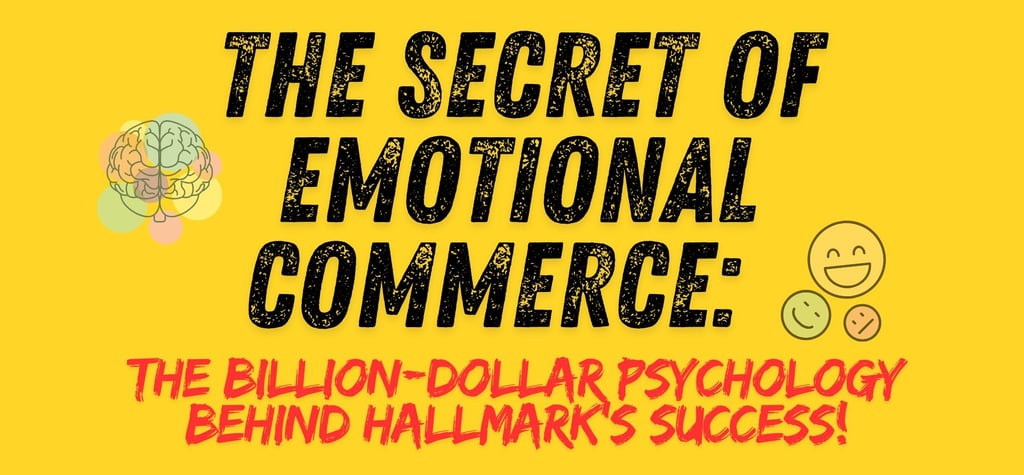The Secret of Emotional Commerce: The Billion-Dollar Psychology Behind Hallmark's Success!


Ever wondered why a simple greeting card can feel so essential?
Or why we willingly drop $7.99 on a piece of folded paper with fancy lettering?
Hallmark cracked the code decades ago, and their strategy is a masterclass in buyer psychology.
Let's dive into the marketing genius behind a company that turned emotions into billions.
📈 The Journey: From Postcards to Profits
The story begins with Joyce C. Hall, who arrived in Kansas City with nothing but two shoeboxes of postcards. But here's where it gets interesting:
When their postcard business literally went up in flames, they didn't give up - they innovated
They identified a crucial market need: people wanted more private ways to communicate
They pioneered the "Eye-Vision" display, bringing cards out of drawers and into the spotlight
They became the first company to advertise greeting cards nationally
📝 A Simple Slogan That Stuck
In 1944, Hallmark sealed its legacy with just nine words:
“When You Care Enough to Send the Very Best.”
This wasn’t just a tagline - it was a psychological trigger.
It made NOT sending a Hallmark card feel like you didn’t care enough.
Clever, right?
But that’s just one piece of the puzzle.
🤔 Why We Have to Buy Cards
Picture this:
It’s 4 PM on Valentine’s Day, and you’re feeling like a total rockstar.
You booked the dinner. You bought the roses.
You picked the perfect bottle of wine.
And then… it hits you.
You forgot the card.
Panic mode. You race to the store, sift through dozens of options, and finally grab one that feels right.
You don’t even blink at the price - because this little piece of paper is more than just a card. It’s an expression of love, a moment of connection, a way to show you care.
And that’s exactly what Hallmark wants you to feel.
📈 Hallmark’s Genius Marketing Strategies
Hallmark didn’t become a $3.5 billion empire by accident. Here’s how they leveraged human psychology to dominate the greeting card industry:
✅ Affect Heuristic: We don’t buy greeting cards based on logic - we buy them based on emotion. A Hallmark card isn’t just ink on paper; it’s a keepsake, a memory, a moment.
✅ Social Proof + Buying Triggers: Hallmark didn’t just sell cards; they created traditions. Their ads, seasonal displays, and even holiday movies reinforced card-giving as a social norm.
Now, every holiday or milestone triggers the thought: “I need to get a card.”
✅ Loss Aversion: That nine-word slogan? It subtly implies that if you don’t send a Hallmark card, you don’t care enough. And nobody wants to feel like they don’t care.
See what they did there?
📊 Business Lessons for Every Leader
Hallmark’s success isn’t just about cards - it’s about understanding your customers’ emotions and triggers.
Want to apply Hallmark's success to your business?
Here’s how you can apply their strategies:
1. Make Buying “Feel Right”
Focus on the emotional benefits of your product or service.
Example: Don’t sell a curling iron—sell confidence and lasting curls.
2. Leverage Trigger Events
Identify the exact moments when your customers are ready to buy.
Hot take: Timing is almost more important than what you’re selling.
3. Highlight What’s at Stake
Show customers what they stand to lose by not choosing your product.
Example: A productivity tool isn’t just about efficiency—it’s about saving time and energy.
💡 Takeaway
Hallmark’s success isn’t just about selling greeting cards - it’s about selling emotions.
And when ~95% of buying decisions are emotionally driven, it’s no wonder we’re willing to spend $7.99 on a piece of paper that says exactly what we feel.
They solved a pain point most people didn’t even realize they had:
the need to express emotions in a way that feels personal, thoughtful, and effortless.
And they did it so well that buying a greeting card now feels necessary.
That’s marketing at its finest.
🔔 Follow for More: Don't miss out on future articles packed with practical tips and inspiring ideas.
Visit my website Kamaleonte Marketing.
Subscribe to my newsletter AI Sapiens.
Stay informed, stay adaptable, and keep thriving
